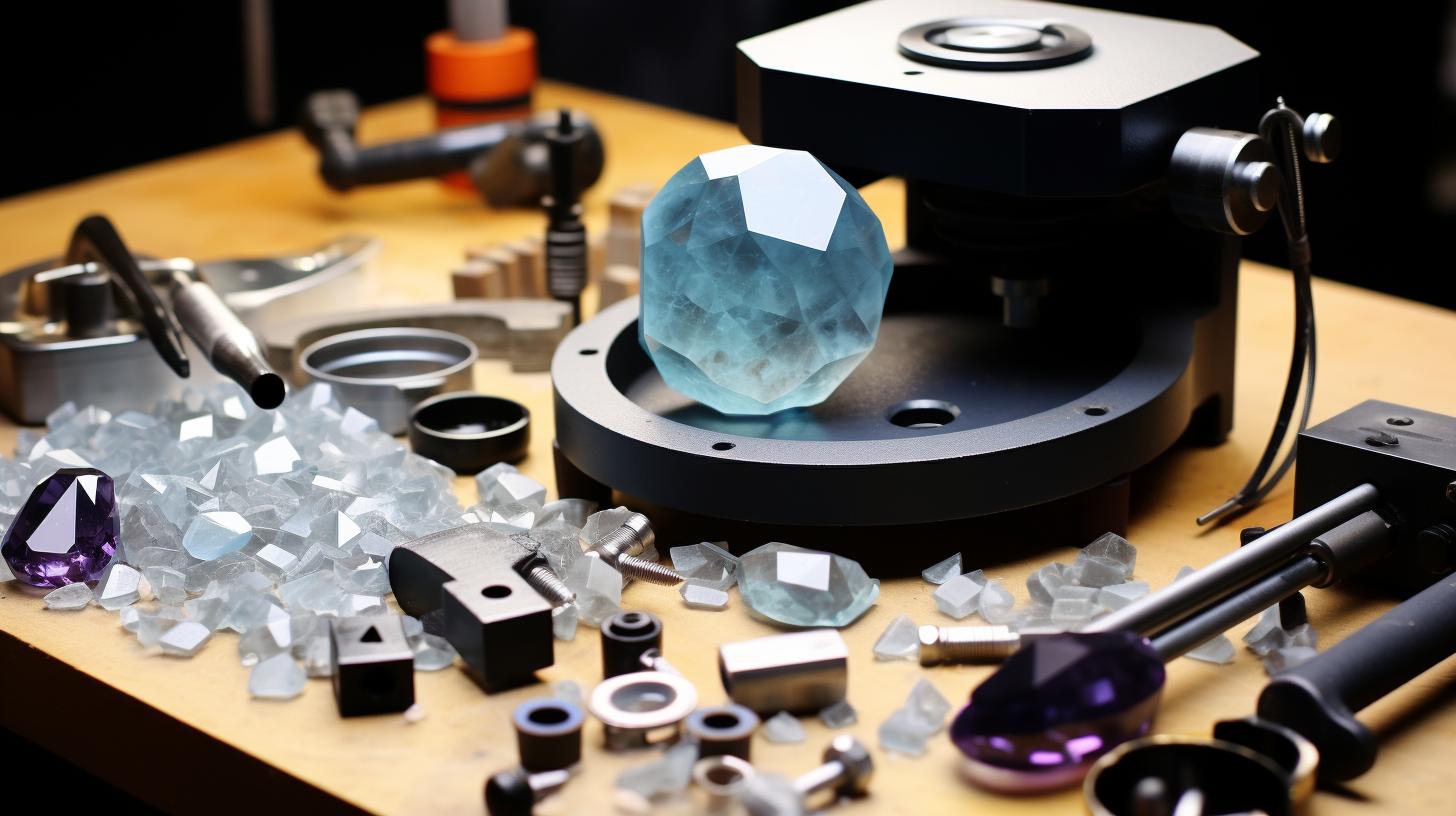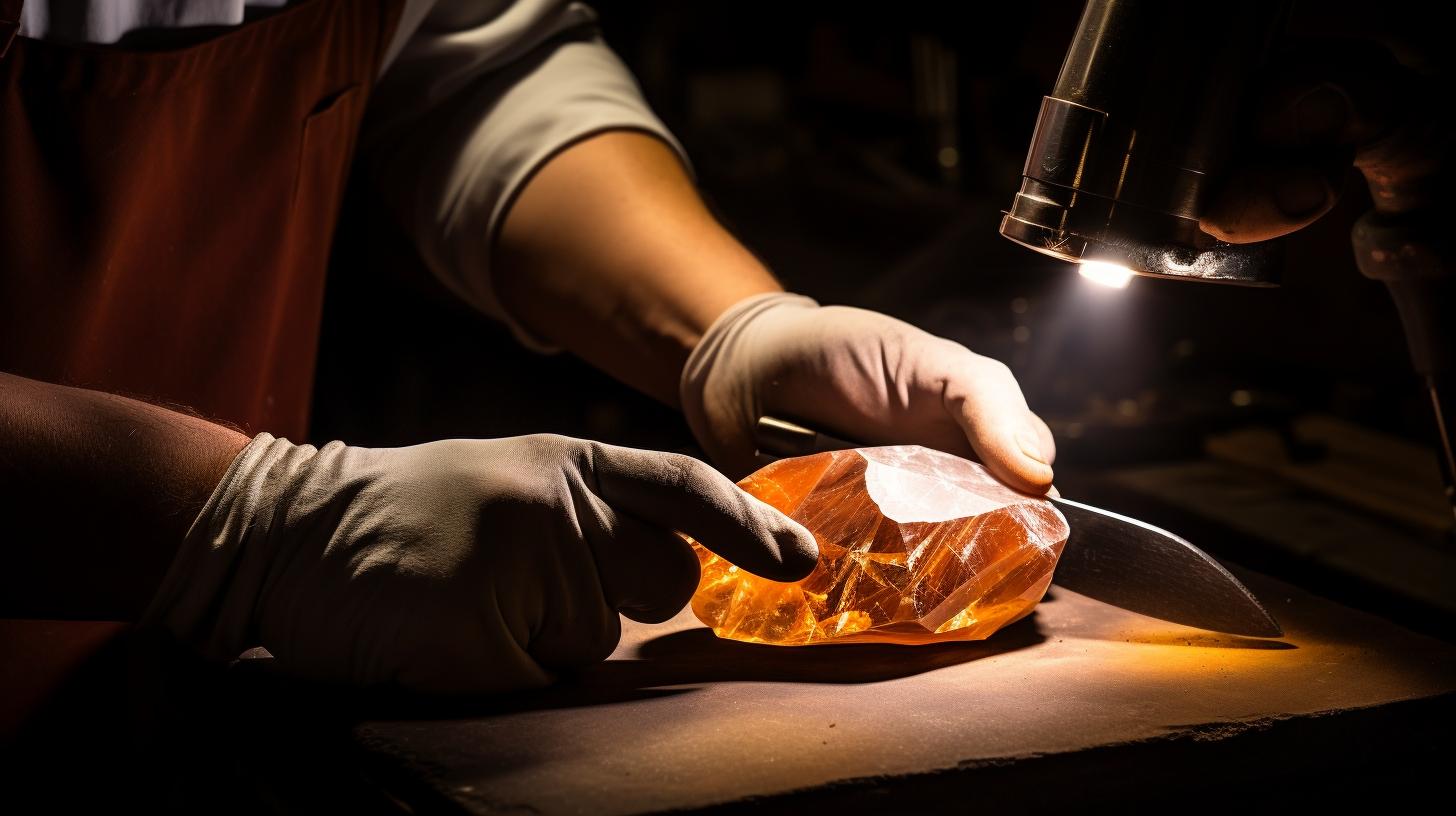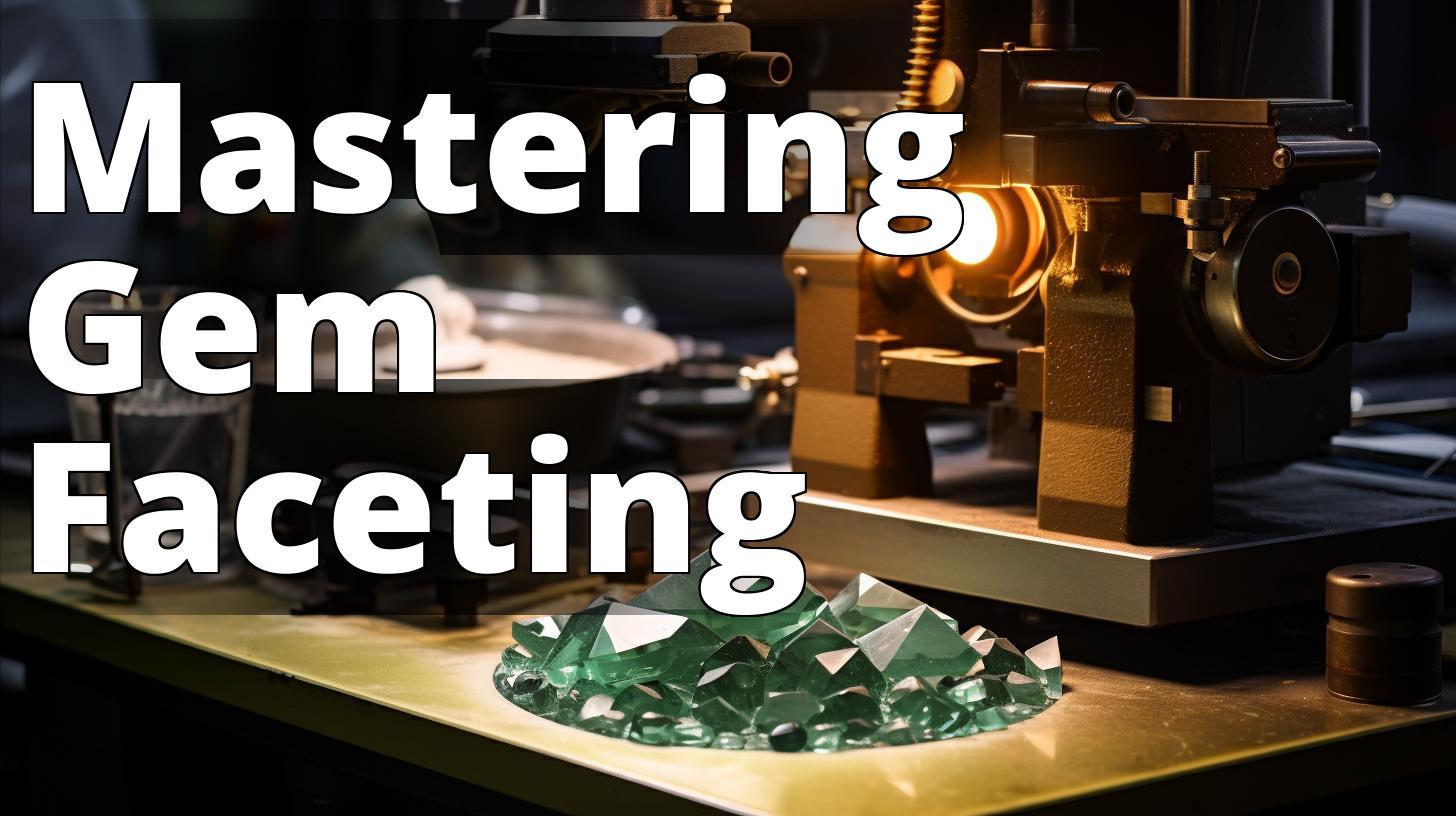Are you a rock polishing and lapidary hobbyist looking to advance your skills and create stunning gemstones? Look no further than lapidary faceting techniques. These techniques involve cutting and polishing surfaces on a crystal to create beautiful gems. With a little patience and craftsmanship, learning the standard cuts is achievable for beginners and can make all the difference in creating a high-quality gem. In this article, we’ll cover everything you need to know to get started with lapidary faceting techniques.
A. Definition of Lapidary Faceting Techniques
Lapidary faceting techniques involve cutting and polishing surfaces on a crystal to create beautiful gems. To get started with lapidary faceting techniques, you’ll need a few basic tools and equipment, which we’ll cover below.
B. Importance of Lapidary Faceting Techniques
Lapidary faceting techniques are an essential skill for any rock polishing and lapidary hobbyist. With these techniques, you can create stunning gemstones that are perfect for jewelry making or other decorative purposes. Plus, mastering lapidary faceting techniques can be a fun and rewarding hobby that allows you to express your creativity.

C. Basic Tools and Equipment Needed
Before we dive into lapidary faceting techniques, let’s cover the basic tools and equipment you’ll need to get started:
- Faceting machine
- Dop sticks
- Dop wax
- Polishing lap
- Diamond paste
The Ultimate Guide to Lapidary Faceting Techniques
- Lapidary faceting techniques involve cutting and polishing gemstones to create facets for enhanced beauty and brilliance.
- This article covers the types of faceting machines, the process of preparing the stone, setting the angle, cutting the facets, polishing the gemstone, adding finishing touches, and safety considerations.
- It also provides resources for learning lapidary faceting techniques, including books, websites, and classes.
Types of Faceting Machines
There are two main types of faceting machines: manual and automatic. Each has its pros and cons, and the right choice will depend on your needs and budget.
A. Manual Faceting Machines
Manual faceting machines are operated by hand, and the cutting angle is set manually. These machines are less expensive than automatic faceting machines, making them a good choice for beginners and those on a budget. However, they do require more skill and patience to use effectively.
B. Automatic Faceting Machines
Automatic faceting machines are more expensive than manual machines, but they are also much easier to use. These machines have built-in motors that control the cutting angle, making them the perfect choice for those who want to create high-quality gems quickly and efficiently.
C. Pros and Cons of Each Type
The main advantage of manual faceting machines is their lower cost, making them a great choice for beginners. However, they do require more skill and patience to use effectively. On the other hand, automatic faceting machines are more expensive but are much easier to use. They are also faster than manual machines, making them a good choice for those who want to create high-quality gems quickly.
D. Tips on Choosing the Right Machine
When choosing a faceting machine, it’s important to consider your budget, skill level, and the type of gems you want to create. If you’re a beginner, a manual faceting machine may be the best choice, as it will allow you to learn the basics without breaking the bank. If you’re more experienced or want to create high-quality gems quickly, an automatic faceting machine may be the better choice.
| Manual Faceting Machines | Automatic Faceting Machines |
|---|---|
| Operated by hand | Operated by built-in motors |
| Cutting angle set manually | Cutting angle controlled by machine |
| Less expensive | More expensive |
| Requires more skill and patience | Easier to use |
| Good for beginners and those on a budget | Perfect for creating high-quality gems quickly |
Preparing the Stone
Before you can begin cutting and polishing your gemstone, you’ll need to prepare it properly. This involves cleaning the stone, marking it, and then dopping it.
A. Cleaning the Stone
The first step in preparing your stone is to clean it properly. This involves removing any dirt, dust, or debris from the surface of the stone. To do this, simply wash the stone in warm, soapy water and dry it thoroughly.
B. Marking the Stone
Once your stone is clean, you’ll need to mark it to ensure that you cut it properly. To do this, use a marker to draw a line around the girdle of the stone. This will act as a guide when you begin cutting the facets.
C. Dopping the Stone
Dopping is the process of attaching the stone to a dop stick using dop wax. This allows you to hold the stone securely while you cut and polish it. To dop your stone, heat the dop wax until it becomes soft and pliable, then attach the wax to the dop stick and press the stone onto the wax.
D. Choosing the Right Dop Wax
When choosing dop wax, it’s important to choose a wax that is strong enough to hold your stone securely but not so strong that it damages the stone. Look for a wax that is specifically designed for lapidary work, such as the dop wax available at Essential Lapidary Tools and Equipment.
Setting the Angle
The next step in lapidary faceting techniques is to set the cutting angle. This involves determining the correct angle for your stone and then setting the angle on your faceting machine.
A. Determining the Correct Angle
The correct cutting angle will depend on the type of gemstone you’re cutting. To determine the correct angle, consult a faceting chart, such as the one available at International Gem Society. This chart will give you the correct angles for different gemstone shapes.
B. Setting the Angle on the Machine
Once you’ve determined the correct cutting angle, it’s time to set the angle on your faceting machine. To do this, adjust the protractor arm on your machine until it is at the correct angle.
C. Tips on Adjusting the Angle for Different Gemstone Shapes
Different gemstone shapes may require different cutting angles. To adjust the angle for different shapes, consult a faceting chart and adjust the protractor arm accordingly.

Cutting the Facets
With the angle set, it’s time to begin cutting the facets. There are two main types of cuts: brilliant cuts and step cuts.
A. Types of Cuts
1. Brilliant Cut
The brilliant cut is the most common cut and is used for round and oval gemstones. This cut features triangular facets that radiate out from the center of the stone.
2. Step Cut
The step cut is used for rectangular and square gemstones. This cut features parallel facets that run along the length of the stone.
B. Instructions on How to Cut Each Type
To cut a brilliant cut, begin by cutting the top of the stone, known as the table. Then, cut the crown facets and the pavilion facets.
To cut a step cut, begin by cutting the corners of the stone. Then, cut the crown facets and the pavilion facets.
C. Tips on Controlling the Depth and Width of the Cut
When cutting the facets, it’s important to control the depth and width of the cut. To do this, adjust the angle of the protractor arm and the position of the lap.
Polishing the Gemstone
Once you’ve cut the facets, it’s time to polish the gemstone. This involves using different types of laps and diamond paste to achieve a high-quality polish.
A. Achieving a High-Quality Polish
To achieve a high-quality polish, it’s important to use the right type of lap and diamond paste. Look for a lap that is specifically designed for lapidary work, such as the polishing lap available at Diamond Wheels and Laps. Choose a diamond paste with a grit that is appropriate for your stone and lap.
B. Using the Right Type of Lap
Different types of laps are used for different stages of the polishing process. For the final polish, use a lap made from a soft material, such as tin or lead.
C. Proper Polishing Techniques
To polish the stone, hold it firmly against the lap and move it back and forth in a circular motion. Apply a small amount of diamond paste to the lap and continue polishing until you achieve a high-quality shine.
D. Using Diamond Paste for Final Polishing
For the final polish, use a diamond paste with a very fine grit. Apply a small amount of paste to the lap and continue polishing until you achieve a mirror-like finish.
Finishing Touches
To add some extra flair to your gemstone, consider rounding the edges or adding a special design. You can also use a faceting machine with a special attachment to create unique patterns and designs.
Case Study: Mastering Lapidary Faceting Techniques
As an avid gemstone collector, I always wanted to try my hand at lapidary faceting techniques. I had a beautiful piece of amethyst that I wanted to transform into a dazzling gemstone. With the help of a manual faceting machine, I embarked on my lapidary faceting journey.
Before I started cutting the stone, I carefully cleaned it to remove any dirt or debris. I then marked the stone with a permanent marker to guide my cuts. Using a special dop wax, I secured the stone to a dop stick, ensuring it was firmly in place.
Next, I had to set the correct angle on the machine. It took some trial and error, but with patience, I was able to find the perfect angle for the amethyst. Adjusting the angle for the different facets of the gemstone was a bit challenging, but I followed the instructions provided and made the necessary adjustments.
Cutting the facets was both exciting and nerve-wracking. I opted for a brilliant cut, aiming for maximum sparkle. With each careful cut, the gemstone started to take shape, revealing its true beauty. Controlling the depth and width of the cuts required precision and attention to detail, but I was determined to create a flawless gem.
After cutting the facets, it was time to polish the gemstone. I selected a lap specifically designed for the amethyst and applied the right amount of pressure to achieve a high-quality polish. Using diamond paste for the final polish added an extra level of brilliance to the gemstone.
To add the finishing touches, I rounded the edges of the gemstone to give it a smooth, elegant look. I also experimented with a special design on one of the facets, adding a unique touch to my creation. The manual faceting machine, equipped with a special attachment, allowed me to achieve the desired result effortlessly.
Throughout the entire process, I made sure to prioritize safety. I wore the necessary safety equipment, including goggles and gloves, and ensured proper ventilation in my workspace. Cleaning the workshop regularly helped maintain a safe and organized environment.
By immersing myself in books and online resources, attending classes, and practicing consistently, I was able to master lapidary faceting techniques. It was a rewarding and fulfilling experience, and it opened up a world of possibilities for me in the world of gemstones.
If you have a passion for gemstones and a desire to bring out their true beauty, I encourage you to explore the art of lapidary faceting. With the right tools, knowledge, and practice, you too can create stunning gemstones that will be cherished for generations to come.
Safety Considerations
When working with lapidary tools and materials, it’s important to take proper safety precautions. This includes wearing the right safety equipment, such as a respirator and eye protection, and ensuring that your workshop is properly ventilated and cleaned.
A. Proper Safety Equipment to Wear
When working with lapidary tools and materials, it’s important to wear the right safety equipment. This includes a respirator, eye protection, and gloves.
B. Other Safety Considerations
Other safety considerations include ensuring that your workshop is properly ventilated and cleaned. Be sure to clean up any dust and debris from your work area regularly.
C. Proper Ventilation and Cleaning of the Workshop
To ensure proper ventilation, consider installing an exhaust fan or using a dust collector. Be sure to clean your workshop regularly to prevent the buildup of dust and debris.
Resources for Learning Lapidary Faceting Techniques
If you’re looking to learn more about lapidary faceting techniques, there are many resources available. Consider taking a class, reading a book, or visiting a website dedicated to lapidary work.
A. Books
There are many books available on lapidary work and faceting techniques. Some recommended titles include “Faceting for Amateurs” by Glenn and Martha Vargas and “The Art of Gem Cutting” by Dr. H. C. Dake.
B. Websites
There are also many websites dedicated to lapidary work and faceting techniques. Some recommended sites include International Gem Society and Essential Lapidary Tools and Equipment.
C. Classes
Consider taking a class to learn more about lapidary faceting techniques. Many community colleges and adult education centers offer classes on lapidary work.
D. Tips on Finding High-Quality Tools and Materials
When looking for high-quality tools and materials for lapidary work, consider shopping at a specialty retailer, such as Diamond Wheels and Laps. You can also find a variety of lapidary tools and materials on Amazon.
E. Ways to Advance Skills
To advance your lapidary faceting techniques skills, consider joining a lapidary club or attending a gem show. These events offer opportunities to meet other lapidary enthusiasts and learn more about the craft.
Conclusion
In conclusion, lapidary faceting techniques are an essential skill for any rock polishing and lapidary hobbyist. With the right tools and equipment, and a little patience and craftsmanship, you can create stunning gemstones that are perfect for jewelry making or other decorative purposes. Remember to take proper safety precautions and consult resources such as books, websites, and classes to learn more and advance your skills.
Questions
What is lapidary faceting?
Lapidary faceting is the art of cutting and polishing gemstones to enhance their brilliance and beauty.
Who can learn lapidary faceting techniques?
Anyone with an interest in gemstones and patience can learn lapidary faceting techniques.
How can I improve my lapidary faceting skills?
Practice regularly, seek guidance from experienced lapidary artists, and experiment with different techniques.
What are some advanced lapidary faceting techniques?
Some advanced techniques include concave faceting, fantasy cuts, and precision angle adjustments.
How long does it take to master lapidary faceting?
Mastering lapidary faceting techniques can take several years of dedicated practice and continuous learning.
But isn’t lapidary faceting equipment expensive?
While some equipment can be costly, there are affordable options available for beginners and budget-conscious enthusiasts.

